Of Animal Love and Abuse
Exploring Ambivalent Human-Animal Relationships in Tiger King (2020) during the COVID-19 Pandemic
1_Big Cats, Extraordinary Human Animals, and Mass Appeal
On April 11, 2020, Girls star Lena Dunham tweeted the following: “Text from my mother: By the way we stopped watching tiger [sic] came because there are no nice people except the Tigers. #TigerKing”. [1] Amidst the vast array of tweets, posts, memes, or other social media content referring to what now counts as one of the most popular Netflix productions to date, Dunham’s post sparked my interest in the show. On the day of the tweet, Tiger King had already turned into a ubiquitous theme of the personalized algorithms determining my digital experience, so I wondered: If a mass-appealing Netflix production inspires a human viewer to include nonhuman animals within the category of ‘people’ — and to stop watching it despite, or maybe rather because of that — could it be worthwhile to examine it from a human-animal studies perspective?
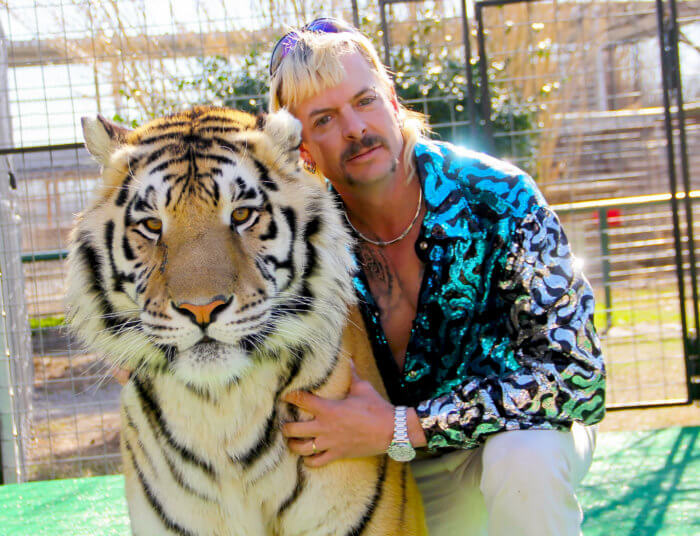
Perhaps unsurprisingly, Tiger King: Murder, Mayhem and Madness (2020) portrays anything but a society that frames tigers as ‘people.’ What at first sight looks like a documentary about illegal US trading and pet-keeping of big cats quickly degenerates into one of the most absurd reality TV shows about murderous, mutilating, mad, and very human animals. Centrally, it traces the feud between Joe Exotic or ‘Tiger King,’ the protagonist whose name inspires the series’ title, and his antagonist Carole Baskin, alleged animal activist who runs the Big Cats Rescue sanctuary. With Exotic now imprisoned for attempted murder for hire of Baskin, the show traces their conflict from various perspectives and pieces of evidence (without taking an overt position on whether Exotic is guilty or not). The tigers and other big cats are both highly present in visual terms — as the show revolves around the two zookeepers’ lives among more than hundreds of these animals — and alarmingly absent in terms of content and context, at least as the show gains momentum. The episodes’ titles trace Exotic’s fall from grace: “Not Your Average Joe” introduces the protagonist, whose “Cult of Personality” is examined further in episode two, “The Secret” starts moving deeper into the crime theme, culminating in “Playing with Fire.” “Make America Exotic Again” then portrays Exotic’s presidential campaign, as he gets increasingly wrapped up in FBI investigations in “The Noble Thing to Do,” up until he is “Dethroned” in the last episode and ends up in jail. The title Tiger King is thus slightly misleading, as the tigers and other big cats rather serve as stage designs in the human reality TV / true-crime documentary blend.
Yet, even though Tiger King is clearly to be distinguished from animal documentaries as emotionally engaging and informatively rich as Blackfish (2013), for example, the big cats’ ubiquitous presence in the midst of humans calls for taking them seriously and uncovering their significance. An animal-centric reading of the show might start well with its title: The words ‘tiger’ and ‘king’ combine to a metaphor that either animalizes Joe Exotic or humanizes the absent tiger. Yet it seems far-fetched that “Tiger King” would refer to a tiger onto whom the human concept of royalty is being transferred, and neither is the concept of personhood, to recall Dunham’s post. Hence the tiger-source of the metaphor is rather being transferred onto a human target here, hinting at an animalization of the human. This might constitute an effective challenge to species binaries from an animal-centric perspective. Could Exotic be understood as some sort of human-animal hybrid — a ‘king’ with ‘tiger’ attributes? At least the series’ German sub-title, Großkatzen und ihre Raubtiere (English: “big cats and their predatory animals”) seems to imply so. Yet perhaps contrastively to such suggested hybridity, Exotic’s eccentric life-style after all reinforces the anthropocentric reasoning behind his hierarchical title, as he cages, exploits, and abuses both his nonhuman inmates and human workers for pleasure, wealth, and self-fashioning.
However, as criticism of the show’s misrepresentation and exploitation of its human and nonhuman characters, its excessive sensationalism, voyeurism, or its general dubiousness in terms of both human and animal ethics floods the internet by now, [2] the present essay seeks to shed light on it from a slightly different angle. I argue that it in fact provides an interesting lens through which to examine the ambivalent relationship between human and nonhuman animals — particularly as practiced between humans and their ‘pets,’ and with interesting intersections to the COVID-19 pandemic. For as Tiger King was launched on March 20, 2020, just when viewers around the globe were experiencing corona-related lockdowns, quarantines, and social distancing, the controversial show turned not only into the streaming provider’s most successful show to date but also into one of the most popular distraction pills for human viewers locked up inside their homes, caged ‘like animals.’ What exactly drew 34.3 million people [3] in the US to the show, only ten days into its release? A newly found empathy for caged living creatures? A longing for excitement and for something so far from ‘normal’ that the monotony of their lockdown days could be pushed aside? Or, to put it in more pessimistic terms, the simple pleasure of being entertained by the shortcomings and miseries of ‘others’? One thing is certain: Tiger King sparks as much discomfort as it does the opposite — judging from social media debates, people love it just as much as they hate it. Or more precisely, most people love it for hating it — with the possible exception of Donald Trump Jr., who shows himself positively surprised in an interview that “none of us knew that you could have had a pet tiger for, like, two grand,” so that maybe, “we should do this,” since having a tiger in the house might be fun. [4]
Even though this should not be the focus here, a brief reflection on the genre to which the show can be attributed sheds light on this ambivalence in viewers’ appeal to it. The first genre Netflix lists is “True Crime Documentaries,” followed by “US TV Shows” and “Docuseries.” Is it thus not about nonhuman animals at all? “He said, imagine ‘Breaking Bad,’ but instead of dealing meth, they’re dealing exotic animals,” co-director Rebecca Chaiklin recalls, marking a striking contrast to an interview statement by director Eric Goode, where he claims that he set out to do “a combination of “Best in Show” [a 2000 mockumentary about show dogs], “Grizzly Man” [a 2005 documentary made of real-life footage by a man living among grizzly bears], and “Blackfish” [a 2013 documentary uncovering the cruelties orcas endure in captivity]. [5] In the interview he implies that in order to “create awareness about the suffering and exploitation of exotic animals […] in a way where you can engage an audience” led him to digress from this animal-centric intention, in order “to dig into the pathology of these characters,” meaning the human ones, of course. [6] Kendra Coulter argues in episode #53 of the Canadian Paw and Order Podcast [7] and in an article in The Globe [8] that the show constitutes “a mirror into our blatant disrespect for animals,” but also admits that it made people address important questions on exotic animal ownership. Mass appeal is certainly not the only channel via which to address animal cruelty effectively, but it can hardly be argued against the fact that Goode did manage to bring the issue to peoples’ attention on a global level.
I see this mass appeal as resulting predominantly from the aforementioned blending of true crime and reality TV elements. The show does not really aspire to uncovering whether Joe has hired a murderer or not, so that — similarly to the exotic animals — the crime story much rather serves as a bait captivating the audience. Hooked by the criminal backbone (remember Breaking Bad), audience members are then to be held in grip by the intimate, absurd, and at times strikingly ‘trashy’ reality TV elements the show adapts when depicting the hillbilly-lifestyle of Florida Man, Joe Exotic. Media studies scholar Laurie Ouellette has observed a recent shift in US television from feature-length, scientific and/or educational documentaries towards
slickly packaged reality series based on unusual, dramatic, and spectacular personal experiences with exploration and the wild, from the labor of deep-sea fishing (Deadliest Catch) to real-life survivalism (Survivalwoman). [9]
Mimicking “the conventions of docusoaps and reality competitions” in recent nature programming stretches the boundaries between fact and fiction or between truth value and entertainment, she continues to argue. [10] This “reality phenomenon” [11] — to which I would carefully link the show in question here — aims at making TV shows appealing to mass audiences; “[w]hether one loved or hated (or both) these emerging reality formats, they became must see TV,” [12] particularly as the debates they spark on social media or other channels result in more people talking about the show than actually watching it. [13] Hence returning back to the core of this contribution, it is this very ambivalence which viewers experience while watching what one might call “trashy” reality TV that makes Tiger King such an interesting case study for exploring human-animal relations in the light of the corona pandemic, as the following two-sided argument will reveal.
In the following section of this article (Part 2), I demonstrate how the corona pandemic causes a contrastive situation for human-animal relations: Whereas the zoonotic origin of the virus calls for an increased distance between humans and nonhumans, lockdowns and social distancing policies simultaneously cause people to get closer to their nonhuman companions [14] with whom they share their homes. Drawing on recent ideas formulated by primatologist Jane Goodall and cultural literary animal studies scholar Roland Borgards, I wonder how Tiger King can be interpreted as a manifestation of this ambivalent situation and whether the corona crisis can be understood as a crucial tipping point and urgent call for a change in the ways humans relate to and treat animals.
Thus establishing the connection to part 3 on human-pet relations, I intend to show how these are led ad absurdum in exotic pet-keeping as it is portrayed in Tiger King. The show’s ambivalent staging of human-animal relationships unveils how humans’ love for nonhumans can go awry and simultaneously draws attention to the fact that ‘companion species’ relations, in the Harawayian sense, can be anything but warm and fuzzy. [15] Plus, as roadside zoos [16] can be interpreted as the wet markets of the US and the product of an anthropocentric longing to dominate wild animals, I further wonder about how the hype around the show connects to the pandemic situation outlined in Part 2. By taking both sides of the argument into consideration, it is examined how the show epitomizes the current state human-animal relationships find themselves in, as the zoonotic pandemic calls for an increased human-animal distancing but simultaneously puts emphasis on forms of human-nonhuman entanglements. The aim is thereby to demonstrate that an interesting potential for change lies within this critical moment, as the discrepancy between a wish for a verified ‘anthropological difference’ [17] — the presumed feature to distinguish humans from nonhuman animals — and the simultaneous longing for intimate human-animal bonds intensifies.
2_Human-Animal Relations and the Corona Pandemic
If we just carry on with business as usual, this will lead to the end of our species on planet earth. [18]
In a recent webinar hosted by the campaigning group Compassion in World Farming and the European Parliament, primatologist Jane Goodall emphatically designates the corona pandemic a wake-up call for humanity to change their relationship to nonhuman animals. Particularly with an eye on the COVID-19 hotspots in slaughter facilities, which provide cozy conditions for diseases to emerge and spread [19] and thus receive increased media attention recently, [20] Goodall expresses hope that the pandemic could and should inspire “projects to make the world a better place for people, animals, and the natural world.” [21] Perhaps too optimistically, she argues that were humankind to realize they are a part of and not apart from the natural world, they may want to treat its nonhuman inhabitants with the appropriate respect.
And in many respects the crisis already did bring nonhuman animals to the fore. Whereas funny, cute, or awareness-raising animal-related content on social media is far from a new occurrence, home-office work accompanied by digital meetings now cause our nonhuman roommates to make occasional appearances in the work-space, entering not only our private but also our work-related conversations. Particularly in places where lockdowns were stricter, owning a dog might have been one of the few tickets allowing people to leave their homes, [22] causing not only a rise in dog foster applications but also the parks and riversides of cities to transform into seemingly the only outdoor spaces still ‘alive.’ Yet above all, animals started to occupy center stage in more public debates played out by scientists and journalists, who kept busy debating on who to blame for COVID-19 to cross the species barrier and spread around the globe: Whether bats generally spread corona viruses [23] or only if under stress due to human encroachment, [24] or whether the scaly pangolin is to blame, [25] who turns out to be the most illegally-traded wild animal world-wide; it seems clear that nonhuman animals must have served as an intermediary host to distribute the product departing from Wuhan’s wet-market (there is some consensus on that point). “Mystery deepens over Animal Source of Coronavirus,” runs one of the more curious headlines, [26] and it might have come as a shock that eventually, even our beloved house-cats were framed as possible suspects in the often rather polemical media coverage. [27]
Now, what is at stake in these conversations in terms of practicing and thinking human-animal relations? Addressing particularly the latter part of this question, in a lecture series entitled “Tiere im lock-down” in May 2020, [28] Roland Borgards argues that what it all boils down to appears to be the question of the ‘anthropological difference’ [29] — the ancient philosophical dispute of where the differentiating line between the ‘human’ and the ‘animal’ is supposed to lie. [30] So-called zoonotic diseases such as Ebola, HIV, BSE, the Spanish flu, or COVID-19 can turn into potentially lethal pandemics that threaten human society on all conceivable levels, as both history and the present have painfully revealed. [31] Zoonoses emerge when pathogens manage to jump from nonhuman animal- onto human animal-host, as it probably happened in Wuhan. [32] Consequently, whether we blame the animals for infecting us, or rather ourselves for destroying their habitat and getting too close to particularly wild animals, and above all to trade these around the globe into foreign ecosystems, the conclusion seems clear: Human beings should keep a safety distance to the alien ‘animal world.’
Against this background, briefly recall that Joe Exotic shares his life with 176 tigers and other big cats, according to the Netflix show. And, to add another ambivalent parameter to the question of the anthropological difference: Right now, scientists around the world are testing the life-saving COVID-19 vaccine on animals, [33] justified by an alleged similarity of the two species’ immune systems, whereas opponents call for an insufficient transferability of research results from animals to humans. [34] So are the species now utterly different from, or eerily similar to one another?
Interestingly and despite this rather anthropocentric perception of both the origin and the practical implications of the pandemic, there is also a current rapprochement between the two opposing animal species to be noted. In her talk on “Narratives of nature and the human-animal relationship during lock-down on social media,” Birte Wrage provides a comprehensive overview on the diverse ways in which humans represent animals on social media and other online platforms during lock-down. [35] Next to the dominant narrative of a thriving nature in the absence of humans (see Figure 2), she identifies the “relatable animals narrative,” [36] both of which work towards confirming the anthropological difference, as Borgards responds to her in his talk. [37] Yet the latter still works into a productive direction, as it invites reflections on human and nonhuman animals to switch positions on their presumedly opposing sides of the species divide, an idea that becomes interesting when looking at Tiger King.
This potential derives from the aforementioned discrepancy between an animal-distancing in the form of humanizing animals in representation on the one, and an animal-rapprochement in the form of cross-species empathy [38] on the other hand. Wrage here refers to various social media content that compares humans in lockdown to captive animals (e.g. Figure 3), or that portrays how animals engage in corona-related practices such as hands-washing. [39] Unfortunately, information on how the pandemic affects real animals — as in slaughterhouses, laboratories, or transportation — remains hard to find, so that this anthropomorphic (or ‘humanizing’) portrayal of animals during COVID-19 often results in a narcissistic self-portrayal of humans. We see something similar happening in Tiger King, where what might have started off as a documentary about big cats in the director’s first intention turns into a bizarre true crime / reality TV blend. “Even when the tigers of Tiger King are in sight, the eye can’t quite meet them,” Michelle Orange notes in her critical review on the show, problematizing the phenomenon of animal representation. [40] Orange convincingly shows how Tiger King reduces the tigers to a so-called “animal-as-spectacle,” [41] which ultimately causes the alive creatures to disappear: “Indeed, we gawped at Joe Exotic while captive in our homes, a direct result of our persistence in encroaching on wild animals, our inability to hold them in view.” [42] Emphasizing this ‘captive state’ of the human audience while watching the series might not circumvent this representational shortcoming, but could it encourage empathy for the captive tigers? The automatized binge-watching function which plays episode after episode without giving you a break is accompanied by its own aura of captivity; and as COVID-19 can be understood as an outcome of the very practice of abusing exotic animals depicted in the show, what else was there to do than to continue watching, despite this discomfort? Even Joe Exotic, now serving a 22-year sentence for attempted murder of Baskin, is now allegedly feeling remorse for keeping his former tigers in cages. [43] This contradictory effect of captivating an audience by sparking intense rejection versus attraction connects to the aforementioned ‘reality phenomenon,’ and it also plays into the construction of human-animal relationships in general.
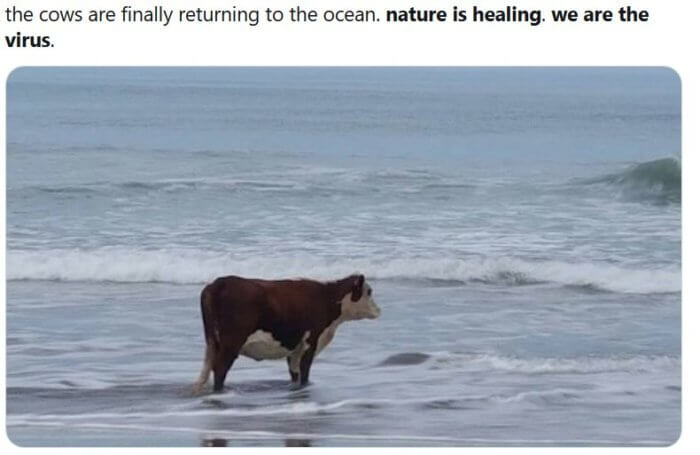
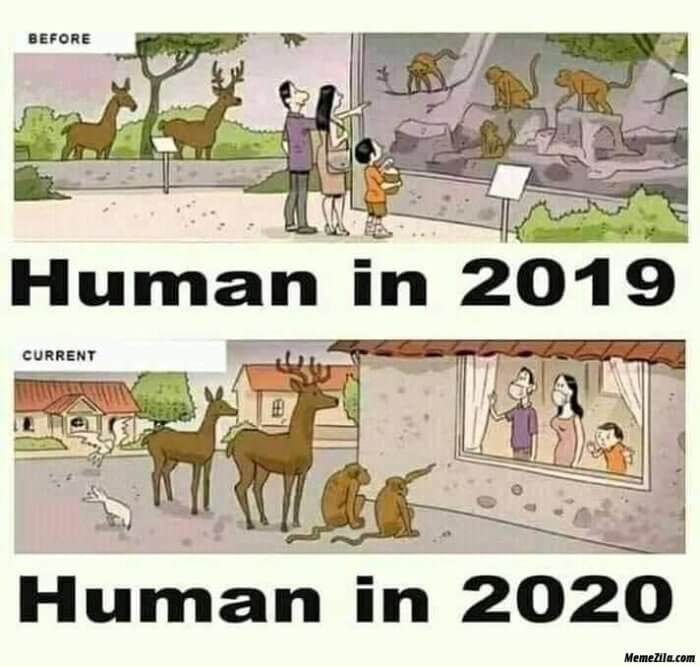
3_Blurring the Line between Animal Love and Abuse: Joe[’s] Exotic[’s] Pets
Tiger King sells itself on its increasingly bizarre twists. What begins as a show about pet tigers ends up involving drug barons, cults and the mysterious disappearance of a multimillionaire. Bingewatch with caution. [46]
This conclusion of Leszkiewicz’s review of the series sums up nicely what most critics of the show agree on: The tigers and with them the suffering and abuse of nonhuman animals is being pushed to the margins of the show, which results in a lack of verisimilitude and thus decreases its ethical or moral value. One of the admittedly few memorable facts the show provides states that “there are more captive tigers in the US today than there are in the wild throughout the world,” stated by a reporter in episode one. The scene then switches to Joe approaching three ‘ligers’ (lion-tiger cross-breeds) and greeting one of them with the words, “[c]ome here, you sexy beast,” followed by diverse content picturing humans living in close quarters with big cats: cuddling, bathing, performing, posing, or — in frequently inserted scene excerpts — being attacked by their ‘pets’. It quickly becomes clear that the documentary is all about handling “with caution” — obviously regarding the exotic animals (human and nonhuman), but also regarding its biased portrayal of facts and fictions, animal cruelty and animal protection, fascination and deterrence, love and abuse.
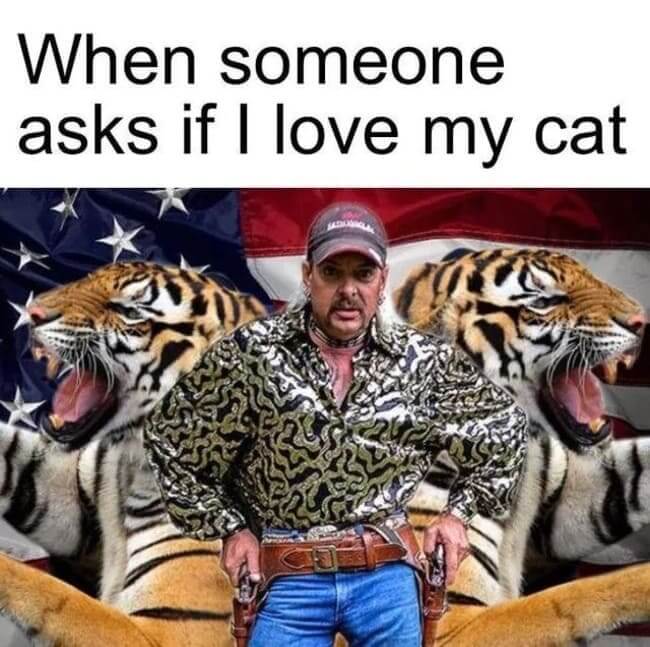
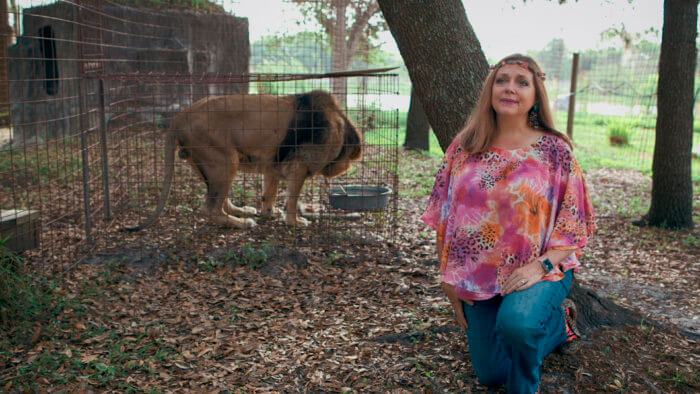
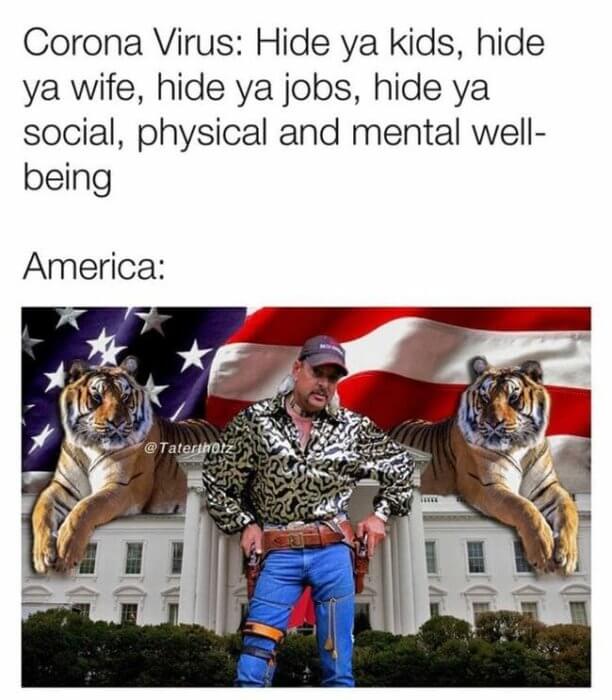
This blurring of the line between animal love and abuse becomes particularly visible in the portrayal of Exotic’s relationship to ‘his’ animals. “Do you have a sense of bonding with them, or do you have a … Ooh,” a reporter asks him, interrupted as a tiger tries to bite Exotic’s stroking hand. “There is a very emotional connection between me and these cats. Extreme,” he ensures him with what seems like a manic grin. As the reporter asks whether the two tigers in the background are trying to mate with each other, Exotic bursts out laughing and points to the fact that they are two males, but that “we have a very open relationship here” and that “we do not discriminate” [my emphasis], directing the audience right away to the themes the show will be addressing later on: polyamorous, homosexual love relationships, the exploitation of animals for money and self-fashioning (Joe does not only run a roadside zoo but also produces an internet broadcast of his life with the cats), but also seemingly affectionate cross-species bonds (“Come here, love me, come here, love me,” Joe repeats while playing with what looks like a lion-jaguar cross) that quite often result in brutal attacks. As the scope of this essay does not allow for more detail, the point being that this juxtaposed portrayal of affection and violence, fascination and exploitation, human-animal bonding and distancing — at times even in the form of killing the animal — runs through all the seven episodes. Exotic might try to live in a ‘companion species’ relation [52] with his cats and even includes them within the plural personal pronoun, ‘we,’ but the self-appointed ‘Tiger King’ ultimately reinforces anthropocentric hierarchies of the worst kind.
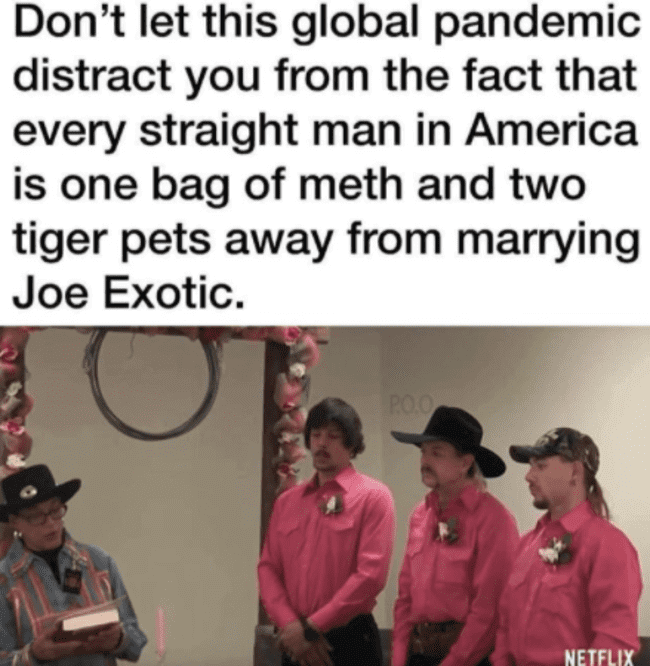
I wonder whether the appeal in keeping exotic or wild animals as pets lies in the possible evasion of this dilemma. Without diving deeply into the less peaceful chapters of human-animal history at his point, historian Erica Fudge has shown that one possible reason for humans’ desire to dominate animals is to ensure the anthropological difference. [59] By conditioning, exploiting, and in the worst cases in torturing their companions, humans wish to prove that they are not only clearly distinguished from but also ultimately superior to nonhuman animal species, so Fudge argues. [60] The harder an animal is to tame, the more effective the challenge of proving human superiority. Right in episode one, Exotic is portrayed on stage with ‘Thunder’ and ‘Lighting,’ explaining to his audience that, “[t]he only difference between my pet and your pet is, mine have three-inch teeth, and they weigh 400 pounds;” and they quickly gain a hundred pounds in his next statement, in which he admits, “[d]oes it feel good to stand on my stage with 500-pound tigers and everybody envy you? Absolutely.” Marking a morbid contrast to Exotic’s declarations of love towards the animals, his former employees reveal in the special episode that they have seen him shoot tigers right in the head, merely “because he was pissed off” or “because he needed the cage space.” Next to fascination and self-fashioning, could the wish for a verified anthropological difference be a core motivator for Exotic’s animal abuse?
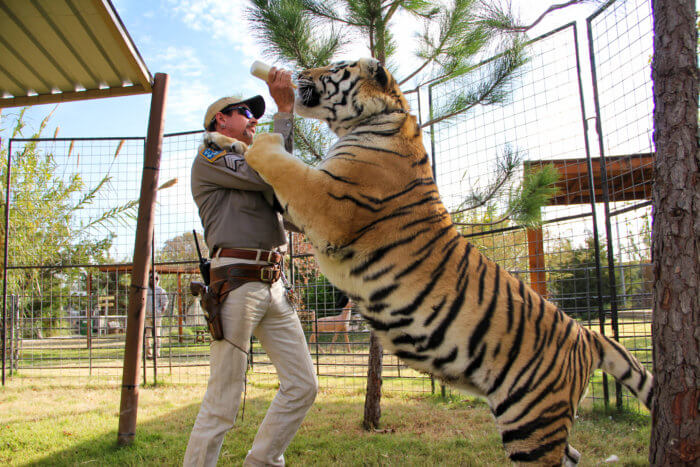
4_Challenging Anthropocentrism, Or, How to Live Well Together
It is certainly not as simple as that. Human-animal relations never are, but if Tiger King is onto something besides making massive profits, then its potential lies in its rich and controversial staging of human-animal encounters. Unfortunately, these fade further and further into the background as the series degenerates into a sensationalist reality TV show. “I didn’t set out to solve a murder. I set out to expose the issue with big cat ownership in America and where that exploitation lies,” Eric Goode states in the aforementioned article bearing the provocative title, “Animals, Sex and Guns? Eric Goode Knew ‘Tiger King’ Had Potential.” [61] Whether this is true or not, the full range of Tiger King’s portrayal of human-animal relations can hardly be done justice in the form of this brief article.
What I intended to show was the rich intersection between the corona pandemic as perceived as a crucial tipping point in the practice and theory of human-animal relations, exotic animal trade and pet-keeping, and spectators’ ambivalent fascination and outrage in connection to Joe Exotic’s absurd lifestyle. Exotic animal trafficking as happening in Wuhan can be understood as a symptom of the same anthropocentric reasoning enabling this lifestyle to pay off — both financially and ideologically. It is the same argumentative strand which makes people pay for having their picture taken with a ‘cute’ lion or tiger cub who is to be disposed of as soon as he or she has grown too big and dangerous for the job. As human animals we need to expose and challenge such anthropocentric thinking and make people realize that the anthropological difference is anything but set in stone. As long as nonhuman animals are understood as mere resources for amusement, emotional support, food, clothes, or for the mere exhibition of human supremacy, the change in “peoples’ hearts” Goodall hopes to result from our current state of crisis seems out of reach. Yet the increased attention human-animal entanglements are receiving right now provide reasons for hope — whether voluntarily in the home and office space, involuntary in tracing the source of the pandemic, in the shape of animal-sympathetic lecture series, or even in the shape of commercially-produced binge-watching material. And already, voices addressing the question of how human-animal relations could change for the better after COVID-19 are getting louder. [62]
_How to Cite
Liza B. Bauer. “Of Animal Love and Abuse: Exploring Ambivalent Human-Animal Relationships in Tiger King (2020) during the COVID-19 Pandemic.” On_Culture: The Open Journal for the Study of Culture 9 (2020). <http://geb.uni-giessen.de/geb/volltexte/2020/15447/>.

_Endnotes
- [1] Lena Dunham, “Text from my mother,” April 11, 2020, accessed June 22, 2020, <https://twitter.com/lenadunham/status/1248806866173321217>.
- [2] See, for example, Rachel Nuwer’s “Why ‘Tiger King’ Is Not ‘Blackfish’ for Big Cats,” in The New York Times, April 9, 2020, accessed June 15, 2020, <https://www.nytimes.com/2020/04/09/science/tiger-king-joe-exotic-conservation.html> ; Kendra Coulter’s “Tiger King isn’t a coronavirus distraction; it’s a mirror into our blatant disrespect for animals,” accessed June 22, 2020, <https://www.theglobeandmail.com/opinion/article-tiger-king-isnt-a-coronavirus-distraction-its-a-mirror-into-our/> ; Alissa Wilkinson’s “Let’s think twice about Tiger King,” accessed June 15, 2020, <https://www.vox.com/culture/2020/4/2/21202812/tiger-king-bad-review-netflix-memes> ; or Anna Leszkiewicz, “In case you missed it… Tiger King,” in The New Statesman, April 3–23, 2020, 71.
- [3] This number of US viewers refers to data collected by Nielsen Ratings, which is referred to in nearly all articles published on the show. See, for example, Todd Spangler, “‘Tiger King’ Nabbed Over 24 Million U.S. Viewers in First 10 Days, Nielsen Says,” accessed June 22, 2020, <https://variety.com/2020/digital/news/tiger-king-nielsen-viewership-data-stranger-things-1234573602/> ; or Julia Alexander, “Netflix Says Tiger King is as Popular as Stranger Things,” accessed June 22, 2020, <https://www.theverge.com/2020/4/21/21229440/tiger-king-netflix-numbers-nielsen-ratings-earnings-series-stranger-things-money-heist>.
- [4] Donald Trump Jr., “Donald Trump Jr. on ‘Tiger King’,” interview by SiriusXM, accessed June 22, 2020, <https://www.youtube.com/watch?time_continue=186&v=r2OJ1PWwwWQ&feature=emb_title>.
- [5] Dave Itzkoff, “Animals, Sex and Guns? Eric Goode Knew ‘Tiger King’ Had Potential,” in The New York Times, April 1, 2020, accessed June 15, 2020, <https://www.nytimes.com/2020/04/01/arts/television/tiger-king-eric-goode.html>.
- [6] Ibid.
- [7] Peter Sankoff and Camille Labchuk, “#53: Kendra Coulter On Tiger King, Covid, & Our Blatant Disrespect for Animals,” Paw & Order, Animal Justice, April 17, 2020, accessed June 30, 2020, <https://www.animaljustice.ca/podcast/53-kendra-coulter-on-tiger-king-covid-our-blatant-disrespect-for-animals>.
- [8] “Tiger King isn’t a coronavirus distraction; it’s a mirror into our blatant disrespect for animals,” April 9, 2020, accessed June 22, 2020, <https://www.theglobeandmail.com/opinion/article-tiger-king-isnt-a-coronavirus-distraction-its-a-mirror-into-our/>.
- [9] Laurie Oullette, ed., A Companion to Reality Television (Malden: Wiley & Sons, 2014), 2.
- [10] Ibid.
- [11] Ibid., 3.
- [12] Annette Hill, “Reality TC Experiences. Audiences, Fact, and Fiction,” in A Companion to Reality Television, ed. Laurie Ouellette (Malden: Wiley & Sons, 2014), 116–133, here: 126.
- [13] TV critic Judy Berman notes that Americans’ exhaustion with the Trump era might have caused the “new wave of hedonistic reality television,” a trend that dominantly flourished in the early 2000s. See Judy Bernam, “Trashy reality TV is back, baby!” in Time Magazine, March 4, 2019, accessed July 23, 2020, <https://www.magzter.com/de/article/News/TIME-Magazine/Trashy-Reality-Tv-Is-Back-Baby>.
- [14] The term ‘companions’ here is understood in the sense of Donna Haraway’s conception of “companion species,” introduced in The Companion Species Manifesto: Dogs, People, and Significant Otherness (Chicago: Prickly Paradigm, 2003); and When Species Meet (Minneapolis and London: University of Minnesota Press, 2007).
- [15] Ibid.
- [16] For detailed information on US roadside zoos, see, for example, Sharon Guynup, “Captive tigers in the U.S. outnumber those in the wild. It’s a problem,” in National Geographic, November 14, 2019, accessed June 30, 2020, <https://www.nationalgeographic.com/animals/2019/11/tigers-in-the-united-states-outnumber-those-in-the-wild-feature/>.
- [17] The so-called ‘anthropological difference’ refers to an ontological distinction of the ‘human’ from the ‘animal’ world by means of capacities. Cultural animal studies is based on the conviction that the question of an ontological anthropological difference should be avoided and replaced by an attention to species difference instead, hence declaring the former a socio-cultural construct, as Borgards argues in his contribution to the collected volume Animal Encounters: Kontakt, Interaktion und Relationalität, eds. Alexandra Bӧhm and Jessica Ullrich (Berlin: J.B. Metzler, 2019), 85–99. Philosopher Giorgio Agamben develops his notion of a socio-political ‘anthropological machine’ as a performative apparatus constantly working towards maintaining this difference, which he lays out in L’aperto: L’uomo e l’animale (Turin: Bollati Boringhieri, 2002).
- [18] The full webinar hosted by Compassion for World Farming took place on June 2, 2020 and can be watched online. <https://www.ciwf.eu/news/2020/06/jane-goodall-tells-eu-if-we-dont-do-things-differently-were-finished?utm_campaign=factoryfarming&utm_source=twitter&utm_medium=ciwf&fbclid=IwAR2E7fRsqnAwJRwqZlPcMPUcjvyZgpKH0EXO3MW5IyoLKV4ZKIR6TbVUnPM>.
- [19] See Rob Wallace, Big Farms Make Big Flu (New York: Monthly Review Press, 2016).
- [20] Especially in the past few weeks at the time of writing, German slaughterhouses have increasingly become under fire. See, for example, Jule Reimer, “Warum die Arbeitsbedingungen in Schlachtbetrieben so prekär sind,” in Deutschlandfunk, accessed June 26, 2020, <https://www.deutschlandfunk.de/covid-19-ausbrueche-warum-die-arbeitsbedingungen-in.2897.de.html?dram:article_id=476511>.
- [21] Compassion for World Farming.
- [22] Michelle Orange, “The Art of Watching: Looking at Animals Looking at Us,” in Virginia Quarterly Review 96.2 (2020), 203–205, here: 204.
- [23] For an epidemiological perspective see, for example: Jie Cui, Naijian Han et al., “Evolutionary Relationships between Bat Coronaviruses and Their Hosts,” in Emerging Infectious Diseases 13 (2007), 1526–1532.
- [24] See Marlene Nowotny, “Gestresste Fledermäuse übertrugen das Virus,” in Science ORF.at, March 31, 2020, accessed June 24, 2020, <https://science.orf.at/stories/3200448/>.
- [25] See Marlene Nowotny, “Gestresste Fledermäuse übertrugen das Virus,” in Science ORF.at, March 31, 2020, accessed June 24, 2020, <https://science.orf.at/stories/3200448/>.
- [26] In this article, David Cyranoski frames the pangolin as “the prime suspect” for “causing havoc around the world” (in Nature, February 26, 2020, <https://www.nature.com/articles/d41586-020-00548-w>). Similar articles on this subject exist in abundance. See, for example, Sherryn Groch, “How does an epidemic spread and what does the wildlife trade have to do with it?,” in The Sydney Morning Herald, April 14, 2020, accessed June 24, 2020, <https://www.smh.com.au/world/asia/how-does-an-epidemic-spread-and-what-does-the-wildlife-trade-have-to-do-with-it-20200129-p53vvm.html> ; Graham Readfearn, “How did coronavirus start and where did it come from? Was it really Wuhan’s animal market?,” in The Guardian, April 28, 2020, accessed June 22, 2020, <https://www.theguardian.com/world/2020/apr/28/how-did-the-coronavirus-start-where-did-it-come-from-how-did-it-spread-humans-was-it-really-bats-pangolins-wuhan-animal-market> ; or Narveen Jandu, “Human activities are responsible for viruses crossing over from bats and causing pandemics like coronavirus,” in The Conversation, May 12, 2020, accessed June 16, 2020, <https://theconversation.com/human-activities-are-responsible-for-viruses-crossing-over-from-bats-and-causing-pandemics-like-coronavirus-134226>.
- [27] See, for example, Janice Kew and John Lauerman, “Coronavirus Came From Bats, Can Infect Cats, Ferrets, WHO Says,” in Bloomberg, May 8, 2020, accessed June 24, 2020, <https://www.bloomberg.com/news/articles/2020-05-08/covid-19-came-from-bats-can-infect-cats-ferrets-who-says>.
- [28] Most of the talks in the lecture series, which not only addresses theoretical but also quite practical issues in terms of the effects of COVID-19 on animal transport, experimentation, agriculture etc., have been recorded and can be found online via: <https://www.vetmeduni.ac.at/de/messerli/infoservice/news-ethik-der-mensch-tier-beziehung/>.
- [29] Roland Borgards, “Coronale Tiere,” in Tiere im lock-down, May 14, 2020, accessed June 28, 2020, <https://eu.bbcollab.com/collab/ui/session/playback >.
- [30] For an anthropological perspective on the concept see Hans-Johann Glock, “The Anthropological Difference: What Can Philosophers Do to Identify the Differences between Human and Non-human Animals?” in Royal Institute of Philosophy Supplement 70 (2012), 105–131.
- [31] For a comprehensive overview on zoonoses, see Rolf Bauerfeind, Alexander von Graevenitz, Peter Kimmig et al., Zoonoses: Infectious Diseases Transmissible from Animals to Humans (Washington DC: ASM Press, 2016).
- [32] In a Guardian article entitled “The Covid-19 pandemic shows we must transform the global food system,” Jan Dutkiewicz, Astra Taylor and Troy Vettese explain how industrial agriculture is the prime cause for pathogens to jump from livestock animals onto humans, particularly when such production sites encroach upon wild habitats (April 16, 2020, accessed June 25, 2020, <https://www.theguardian.com/commentisfree/2020/apr/16/coronavirus-covid-19-pandemic-food-animals>. The 1918 ‘Spanish flu’ allegedly emerged from a US pig farm, in the 1970s, increased reliance on ‘bush meat’ in west Africa lead to the outbreaks of HIV and Ebola, Bovine spongiform encephalopathy (BSE) spread in the UK after meat and bone meal was fed to cattle, both avian and swine flu are the outcomes of intensive animal agriculture.
- [33] See “Tierversuche für Corona-Impfstoffe unverzichtbar,” April 24, 2020, in Pharmazeutische Zeitung, accessed June 25, 2020, <https://www.pharmazeutische-zeitung.de/tierversuche-fuer-corona-impfstoffe-unverzichtbar-117123/>.
- [34] See Volkart Wildermuth, “Tierversuche und ihre Aussagekraft,” in Deutschlandfunk, April 15, 2020, accessed June 15, 2020, <https://www.deutschlandfunk.de/sars-cov-2-tierversuche-und-ihre-aussagekraft.676.de.html?dram:article_id=474663>. There is a discussion going on whether to vaccinate wild animals in order to prevent zoonoses from spreading. See a contribution on the website Animal Ethics, “Helping wild animals through vaccination: could this happen for coronaviruses like SARS-CoV-2,” May 12, 2020, accessed June 30, 2020, <https://www.animal-ethics.org/helping-wild-animals-vaccination-coronaviruses-sars-cov-2/>.
- [35] Wrage’s talk was also part of the afore-mentioned lecture series. The recording can be found at: <https://vetcloud.vetmeduni.ac.at/owncloud/index.php/s/XEDPoFSlCa3BzI7>.
- [36] The first narrative manifests in memes and posts bearing the caption, “We are the virus, nature is healing.” It suggests that in the pandemic-induced absence of humans (e.g. in the reduced air or car travel, the lack of waste, etc.) the nonhuman world starts to thrive once again, so that cities, rivers, oceans, or tea gardens are being rewilded (e.g. dolphins were allegedly appearing in the Venice canals, which quickly turned out as false, triggering numerous posts making fun of this story). The anthropological difference is thus being confirmed in what are primarily fake news or jokes.
- [37] Cf. Borgards, “Coronale Tiere.”
- [38] See, for example, Lori Gruen’s influential concept of “entangled empathy” in Entangled Empathy: An Alternative Ethics for Our Relationships with Animals (New York: Lantern Books, 2015).
- [39] E.g. a video of a chameleon washing his or her hands can be found on Youtube, accessed June 25,2020: <https://www.youtube.com/watch?v=WDnU-s-wPC8>.
- [40] Orange, “The Art of Watching,” 204. As soon as humans portray animals in text, images, videos, or spoken language, their unavoidably anthropocentric perspective shapes this representational act, which is one of the core assumptions of cultural animal studies. See, for example, Nigel Rothfels, ed., Representing Animals (Bloomington and Indianapolis: Indiana University Press, 2002).
- [41] John Berger framed the concept “animal-as-spectacle” in his 1977 essay “Why Look at Animals?” in About Looking (London: Bloomsbury, 1980).
- [42] Orange, “The Art of Watching,” 204.
- [43] Brenne L. Heldman and Christine Pelisek, “Murder & Big Cats! The Wild World of Tiger King,” in People, April 20, 2020, 39–43, here: 40.
- [44] “Nature is Healing,” April 22, 2020, Twitter, accessed July 21, 2020, <https://twitter.com/iamtannenbaum/status/1252801773703770113>.
- [45] “Human in 2019 vs Human in 2020 Meme,” accessed June 25, 2020, <https://memezila.com/Human-in-2019-vs-human-in-2020-meme-1641>.
- [46] Leszkiewicz, “In case you missed it…,” 71.
- [47] “I Love My Cat,” accessed June 20, 2020, <https://knowyourmeme.com/photos/1800067-wholesome-memes>.
- [48] Later in the show it turns out that Baskin started off as a zoo-keeper just like Joe, before she turned her zoo into a sanctuary and started fighting for the implementation of the Big Cats Safety Act. It quickly becomes clear that the show provides as little sympathy for her as it does for the tigers. For reasons of scope, the discrepancy between an animal rights and an animal welfare position (which Baskin embodies vividly) cannot be dealt with here.
- [49] Another shocking fact the series reveals is the massive business of cub-breeding for charging people to have their picture taken while holding a baby lion or tiger. When these cubs grow up and turn into dangerous predators, they are being disposed of, as they are no longer economically valuable.
- [50] Regular zoos in the US are licensed by the Association of Zoos and Aquariums, whereas private roadside zoos are able to obtain their license from the US Department of Agriculture, which requires low standards in terms of animal welfare. For a concise overview on the US legal regulations on big cat ownership, see Kelli Bender, “The Private Zoos on Netflix’s Tiger King Exist Because of These U.S. Exotic Pet Ownership Laws,” in People, March 26, 2020, accessed June 29, 2020, <https://people.com/pets/tiger-king-us-exotic-pet-ownership-laws/>.
- [51] “US Reaction to Corona,” taken from “24 ‘Tiger King’ Memes for Anyone Who’s Obsessed with Joe Exotic,” March 27, 2020, accessed June 20, 2020, <https://www.someecards.com/memes-lists-comics/memes/more-tiger-king-memes/>.
- [52] Donna Haraway derives her influential conception from the Latin term cum panis, denoting ‘with bread,’ and hence defines her ‘companion species’ category as including all species cohabitating spaces of living and dying, which become particularly prominent at the dinner table. Consequently, Borgards wonders whether the corona pandemic with its aforementioned connection to the ways humans treat animals plus the increased proximity between humans and their pets could enable a re-thinking of multi-species living in terms of an entangled ‘natureculture’ — another concept framed by Haraway, which aims at a deconstruction of nature/culture binaries and attends to the vast relational networks between human and nonhuman agents, which the current crisis brings to the fore. Watching Tiger King painfully reveals the need for strict rules needed so that human and nonhuman animals can “get along,” especially when the nonhumans in questions are big cats. In his talk “Coronary Animals” (note 31), Borgards also analyses an insightful “stay at home” video posted by Arnold Schwarzenegger that pictures him in what can be interpreted as a companion species relation with his donkey and pony. See “Arnold Schwarzenegger practices ‘social distancing’ with donkey and pony,” March 16, 2020, accessed June 15, 2020, <https://www.youtube.com/watch?v=TXLdJvzk0FU&t=7s>.
- [53] “Marry Joe Exotic,” taken from “24 ‘Tiger King’ Memes for Anyone Who’s Obsessed with Joe Exotic,” March 27, 2020, accessed June 20, 2020, <https://www.someecards.com/memes-lists-comics/memes/more-tiger-king-memes/>.
- [54] Erica Fudge’s work in historical animal studies provides plenty of insightful material on human-pet relations. Next to her monograph Pets (London and New York: Routledge, 2008), her works Renaissance Beasts: Of Animals, Humans, and Other Wonderful Creatures (Urbana and Chicago: University of Illinois Press, 2004) and Perceiving Animals: Humans and Beasts in Early Modern English Culture (Urbana and Chicago: University of Illinois Press, 2002) are of interest, as is David Perkins’s book on Romanticism and Animal Rights (Cambridge and New York: Cambridge University Press, 2004).
- [55] For a comprehensive examination of the various practices of violence in human-animal relations, particularly with regards to domesticated animals, see Dinesh Wadiwel, The War Against Animals (Leiden: Brill, 2015).
- [56] Particularly in dog training, many quite positive and dog-friendly approaches have by now been developed in order to make that happen. Yet ultimately, even methods such as ‘positive reinforcement’ work via conditioning methods.
- [57] Donna Haraway has developed the notion of a productive ‘work and play’ between humans and animals which can further inter-species communication. She draws particularly on the dog-sport called “agility” she practices with her Australian shepherd, Chayenne. The theme can be found throughout her work, particularly in the chapter “Training in the Contact Zone – Power, Play, and Invention in the Sport of Agility” in When Species Meet.
- [58] See, for example, Mieke Roscher, “Geschichtswissenschaft. Von einer Geschichte mit Tieren zu einer Tiergeschichte,” in Disziplinierte Tiere: Perspektiven der Human-Animal Studies für die wissenschaftlichen Disziplinen, eds. Reingard Spannring, Karin Schachinger, Gabriela Kompatscher-Gufler and Alejandro Boucabeille (Bielefeld: transcript, 2015), 75–100.
- [59] Fudge, Perceiving Animals, 1–33.
- [60] Ibid., 14.
- [61] Itzkoff, “Animals, Sex and Guns?”
-
[62]
In fact, COVID-19 has already sparked several interesting initiatives addressing these issues and working towards a change of human-animal relations. See, for example, a recent catalogue of demands published by the German animal rights organization, Die Tierbefreier, entitled “Forderungen des Bündnisses für gesellschaftliche Tierbefreiung im Kontext der Corona-Krise,” May 30, 2020, accessed June 30, 2020, <http://tierbefreier.org/corona/?fbclid=IwAR3xofsJeYhiwF0S65iAvaetzTK8hLeSRAMEltcl2aPkQPB_htgoVl5Vk> ; or the Animals in Society: Animal Studies Scholar Advocacy blog entitled “After the Pandemic: Re-Imagining Human-Animal Relations,” which has published an open call for blog entries (<https://animalsinsocietygroup.wordpress.com/2020/03/31/call-for-blog-submissions-after-the-pandemic-re-imaging-human-animal-relations/>) with a valuable contribution by Stehanie Eccles, “Imagining Something More During and After Covid-19: Our Bounded Relations,” accessed June 30, 2020, <https://animalsinsocietygroup.wordpress.com/2020/04/16/imagining-something-more-during-and-after-covid-19-our-bounded-relations-by-stephanie-eccles/> ; or a commentary published by Animal Liberation Currents on “Animals, Capitalism and COVID-19,” May 5, 2020, accessed June 30, 2020, <https://animalliberationcurrents.com/correspondence-animals-capitalism-and-covid-19/>.


